
 |

|
| ActiveWin: Reviews | Active Network | New Reviews | Old Reviews | Interviews |Mailing List | Forums |
|
|
|
|
|
DirectX |
|
ActiveMac |
|
Downloads |
|
Forums |
|
Interviews |
|
News |
|
MS Games & Hardware |
|
Reviews |
|
Support Center |
|
Windows 2000 |
|
Windows Me |
|
Windows Server 2003 |
|
Windows Vista |
|
Windows XP |
|
|
|
|
|
|
|
News Centers |
|
Windows/Microsoft |
|
DVD |
|
Apple/Mac |
|
Xbox |
|
News Search |
|
|
|
|
|
|
|
ActiveXBox |
|
Xbox News |
|
Box Shots |
|
Inside The Xbox |
|
Released Titles |
|
Announced Titles |
|
Screenshots/Videos |
|
History Of The Xbox |
|
Links |
|
Forum |
|
FAQ |
|
|
|
|
|
|
|
Windows XP |
|
Introduction |
|
System Requirements |
|
Home Features |
|
Pro Features |
|
Upgrade Checklists |
|
History |
|
FAQ |
|
Links |
|
TopTechTips |
|
|
|
|
|
|
|
FAQ's |
|
Windows Vista |
|
Windows 98/98 SE |
|
Windows 2000 |
|
Windows Me |
|
Windows Server 2002 |
|
Windows "Whistler" XP |
|
Windows CE |
|
Internet Explorer 6 |
|
Internet Explorer 5 |
|
Xbox |
|
Xbox 360 |
|
DirectX |
|
DVD's |
|
|
|
|
|
|
|
TopTechTips |
|
Registry Tips |
|
Windows 95/98 |
|
Windows 2000 |
|
Internet Explorer 5 |
|
Program Tips |
|
Easter Eggs |
|
Hardware |
|
DVD |
|
|
|
|
|
|
|
ActiveDVD |
|
DVD News |
|
DVD Forum |
|
Glossary |
|
Tips |
|
Articles |
|
Reviews |
|
News Archive |
|
Links |
|
Drivers |
|
|
|
|
|
|
|
Latest Reviews |
|
Xbox/Games |
|
Fallout 3 |
|
|
|
Applications |
|
Windows Server 2008 R2 |
|
Windows 7 |
|
|
|
Hardware |
|
iPod Touch 32GB |
|
|
|
|
|
|
|
Latest Interviews |
|
Steve Ballmer |
|
Jim Allchin |
|
|
|
|
|
|
|
Site News/Info |
|
About This Site |
|
Affiliates |
|
Contact Us |
|
Default Home Page |
|
Link To Us |
|
Links |
|
News Archive |
|
Site Search |
|
Awards |
|
|
|
|
|
|
|
Credits |

|
Product: Intel Pentium III 1.13GHz &
D815EEA2 rev. B Review |
Benchmarks
|
Table Of Contents |
Since a review cannot be complete without the usual benchmarks, here we go. To test the Tualatin 1,13GHz we obviously used the Intel D815EPEA2 motherboard. The configuration of the system was:
- Intel D815EEA2 Motherboard (with P03 Bios),
- 384Mb SDRAM PC133,
- Seagate 20GB UDMA 66 Hard Disk,
- Western Digital 6,4GB UDMA 33 Hard Disk,
- GoldStar DVD-Rom 8120b,
- Yamaha CRW2100E,
- Matrox Millennium G550 (with retail drivers),
- Microsoft Office Keyboard,
- Microsoft TrackBall Optical.
Everything was running on a fresh and clean install of Microsoft Windows 2000 Professional with Service Pack 2. We used several benchmarking tools to test the performance of the Pentium III 1,13GHz CPU with its dedicated i815EE chipset that were: CPU Mark, SiSoft Sandra 2001, ZD Content Creation 2001, ZD Business Winstone 2001, SYSMark 2001, CPU Math Mark.
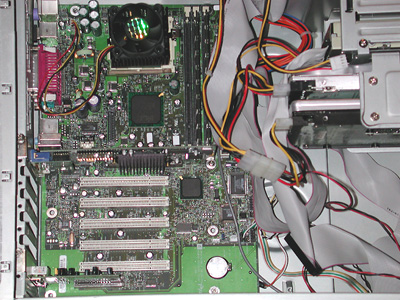
Inside our test system
(click to enlarge)
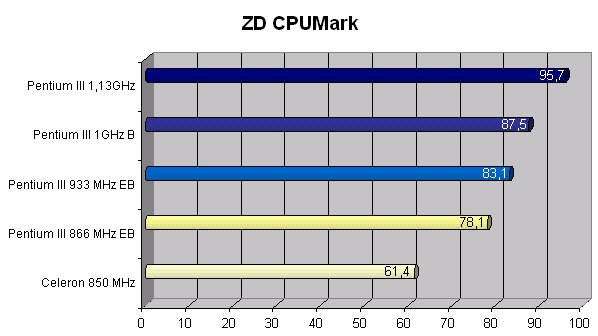 |
|
|
The
CPU Mark benchmark tool reveals the power of the processor.
In all
logic the Pentium III 1,13GHz holds out against previous Pentium III
processors (10% more faster than the PIII 1GHz).
|
|
 |
|
|
MathMark 2.0 trains the processor to
perform some basic and complex mathematic operations (like 9^1500,
calculating iterations of Pi, etc.) Once those tests are completed, it
reports the time it takes for the CPU to achieve such operations in
seconds. It's no surprise to see that the Pentium 1,13GHz is the
Coppermine fastest processor. We have put the score of a P4 1.5GHz
system for comparison purposes.
|
|
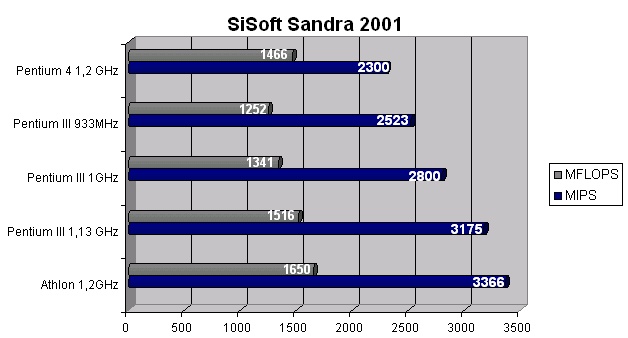 |
|
|
Using SiSoft Sandra 2001
(version 8.11), we benchmarked
various
Pentium III processors using the same Intel D815EEA2
motherboard. As you can see
the
MIPS (
|
|
MFLOPS: The Whetstone benchmark is widely used in the computer industry as a measure of performance. Floating-point arithmetic is most significant in scientific, engineering, statistical and computer-aided design (CAD) programs. It is also a small component in spreadsheet, paint and drawing programs. Word processing programs typically do no floating-point computations at all. The Whetstone does a lot of floating-point arithmetic, some memory access, and a little integer arithmetic.
MIPS: The Dhrystone benchmark is widely used in the computer industry as a measure of performance. Dhrystone is a synthetic benchmark, designed to contain a representative sample of operations normally performed by applications. They don't calculate a result of any kind, but they do perform the sort of complicated sequences of instructions that real applications use. The Dhrystone result is determined by measuring the time it takes to perform these sequences of instructions. Simple integer arithmetic, logic decisions, and memory accesses are the dominant CPU activities in most Windows programs. The Dhrystone benchmark makes intensive use of these areas.
 |
|
| Here are the results the Ziff Davis Content Creation Winstone 2001 benchmark gives. Content Creation Winstone is a system-level, application-based benchmark that measures a PC's overall performance when running top, Windows-based, 32-bit, content creation applications. | |
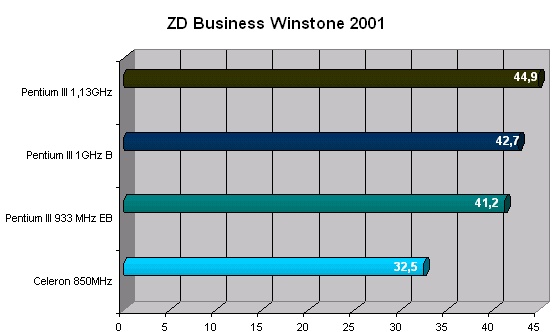 |
|
| Business Winstone is a system-level, application-based benchmark that measures a PC's overall performance when running today's top-selling Windows-based 32-bit applications. Always on top, the Tualatin 1,13GHz is 40% faster than a Celeron 850MHz demonstrating how powerful the Intel Pentium III platform is. | |
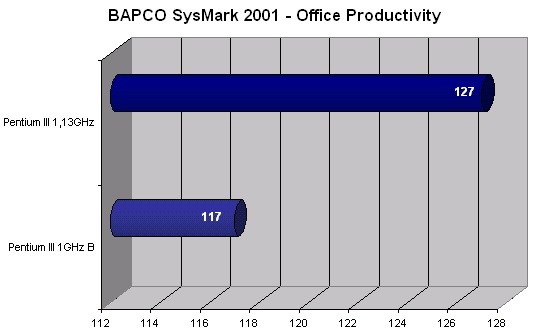 |
|
| Sysmark is a suite of application software and associated benchmark workloads used to measure the global performance of a computer. As you can see the Tualatin 1,13GHz outperforms the Pentium 1GHz by 10%. | |
To conclude, the Intel Pentium III 1,13GHz is to date the fastest and latest Pentium III processor. It manages to surpass the Pentium 4 1.2GHz in SiSoft Sandra 2001 and is hard on the heels of the AMD Athlon 1.2GHz processor. The Pentium III 1,13GHz is definitely a top notch platform to build powerful office computers without spending the whole budget by purchasing an expensive Pentium 4 platform. The tualatin offers enough power for day to day multimedia use as well as hard-core gaming.
